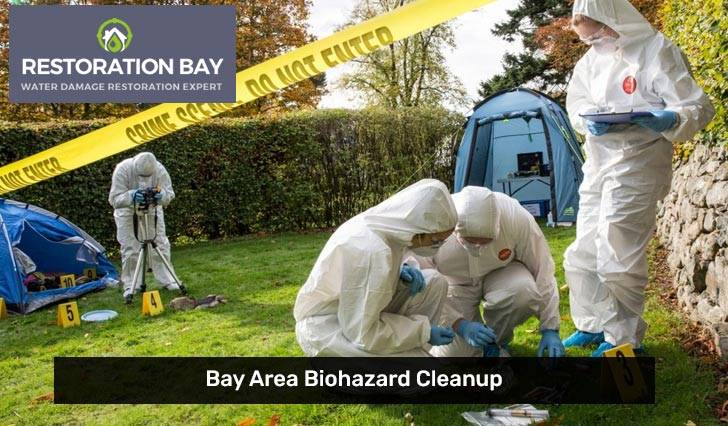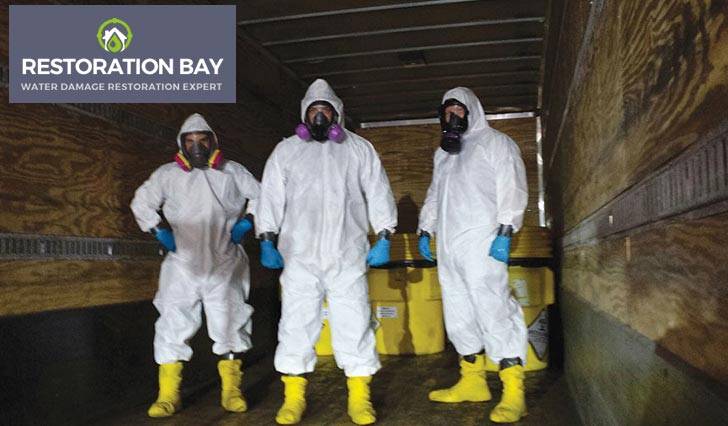- 24/7 Water Damage Emergency
- Direct Insurance Billing
Biohazards like blood, bodily fluids, and other biological materials pose health risks if not handled and cleaned properly. In the Bay Area, both homeowners and business owners must have the necessary knowledge and skills for safe biohazard cleanup.
It’s important to handle biohazards safely in your home or business to prevent harmful exposure and contamination. This means carefully containing, handling, and getting rid of dangerous materials. Ignoring these precautions can result in serious health problems, emphasizing the importance of following safe practices for Bay Area biohazard cleanup.
This ensures the safety of yourself and those around you from potential risks. Read on to equip yourself with the knowledge to protect your environment.

Biohazards are biological substances that can harm living things, especially people. Examples include medical waste, microorganisms, viruses, toxins, human or animal waste, sharp objects like needles, and leftover pharmaceuticals. If not handled and disposed of correctly, these materials can cause illnesses and even death.
Biohazards can vary in homes or businesses, such as bodily fluids like blood from accidents or crime scenes, sharps like used needles in public areas, unsanitary conditions causing mold growth, and unsafe storage of chemicals. Understanding these is key to proper Bay Area biohazard cleanup, as it guides safety measures and cleanup procedures.
Biohazards, such as infectious materials and toxic substances, pose a significant risk of infection, disease transmission, and contamination. Direct or indirect exposure to these hazardous substances can lead to severe health consequences, ranging from respiratory ailments to life-threatening conditions.
That’s why it’s important to handle biohazard cleanup very carefully and skillfully to avoid the spread of diseases or environmental contamination. By ensuring proper handling and disposal methods, we not only safeguard public health but also protect the ecosystem and mitigate potential legal consequences.
Identifying potential biohazards is the first step toward initiating proper cleanup. This process requires a keen eye and a solid understanding of what forms a biohazard. To start, biohazards can be visible such as blood, animal waste, or discarded medical sharps.
However, they can also be invisible to the naked eye, such as bacteria, viruses, and other microorganisms that can be present on surfaces, in water, or even in the air. Indicators of such biohazards can include an unusual smell, visible mold growth, or unexplained illnesses within a specific area.
Recognizing the different types and categories of biohazards can also aid in identification. Biohazard levels range from one to four, with each level representing a specific type of threat:
The type of biohazard can dictate the necessary cleanup procedures, so correct identification is critical. Always remember, when in doubt, it’s safer to treat a potential threat as a biohazard and consult with professionals like Restoration Bay, to ensure a safe and thorough cleanup.
Cleaning up biohazards requires proper equipment, training, and techniques to ensure safety and minimize the risk of contamination. It is crucial to follow strict protocols during cleanup and decontamination processes.
Here are some general steps to follow when handling biohazards:
It is crucial to wear appropriate personal protective equipment, such as gloves, gowns, masks, and eye protection. These measures are essential to prevent any direct contact with biohazards, ensuring your safety during cleanup.
To minimize the spread of contaminants, it is important to isolate the affected area. By implementing proper isolation measures, you can prevent the biohazards from reaching unaffected areas, mitigating the risk of further contamination.
Safely disposing of biohazardous waste is of utmost importance. Always use biohazard bags and puncture-resistant containers for sharps to ensure the secure disposal of waste materials, minimizing any potential harm to individuals and the environment.
Utilize disinfectants that have been approved by the Environmental Protection Agency (EPA). These disinfectants are specifically formulated to effectively eliminate bacteria, viruses, and other harmful microorganisms, providing a clean and safe environment.
Never handle sharps, such as needles, syringes, or blades, directly. Always use appropriate tools like pliers or tongs to minimize the risk of accidental injuries or exposure to biohazards.
During the cleanup process, it is crucial to avoid touching your face or eating until you have thoroughly cleaned your hands post-cleanup. This precautionary measure helps to prevent the potential transfer of contaminants to yourself or others, ensuring safety and hygiene.
In cases of severe contamination, it is highly recommended to seek professional consultation from Restoration Bay. Their comprehensive Bay Area biohazard cleanup services provide expert assistance and guidance, ensuring a thorough and effective cleanup process. Remember, safety should never be compromised.

Proper biohazard cleanup and disposal is a methodical process that warrants explicit attention to detail to ensure the safety and health of everyone involved. Here are the crucial steps involved:
This process is not for untrained individuals. It requires expertise, so when in doubt, consult with Restoration Bay, biohazard cleanup professionals, for advice or services. For professional assistance and adherence to stringent safety standards, reach out to us today!
Biohazards pose a big threat to people’s health and the environment. To reduce risks, it’s important to correctly identify, handle, and clean them up. Following strict safety rules during cleanup is crucial to protect everyone. Spreading awareness and teaching others about proper handling and disposal methods is key to preventing contamination and outbreaks.